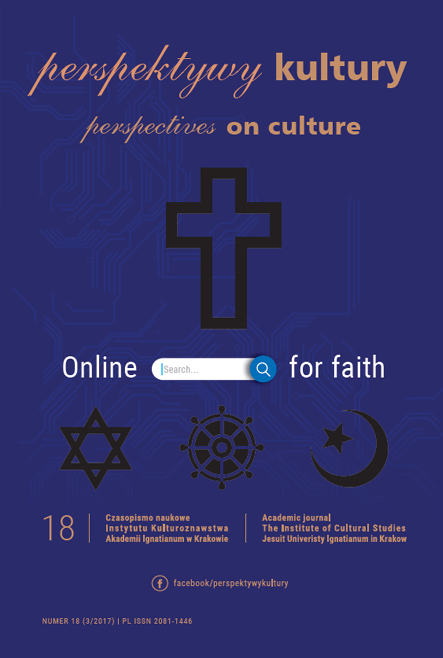World of Warcraft – nową formą religii?
Abstrakt
Autor artykułu bada religijne zjawiska w grze komputerowej World of Warcraft (WoW) i porównuje je z tradycyjnymi religiami, takimi jak chrześcijaństwo czy buddyzm. Według autora, fenomeny religijne wy- stępują w WoW w formie mitów, rytuałów, a także w tworzeniu wspól- not. Te zjawiska nie są zupełnie fikcyjne, ponieważ świat wirtualny wpływa na graczy, w związku z czym należy przyjąć pewien poziom realności fenomenów. Autor uważa, że WoW może częściowo zaspo- koić duchowe potrzeby współczesnego ultranowoczesnego człowieka. Gra nie może jednak w żadnym razie zastąpić tradycyjnej religii, po- nieważ brak jej kluczowego elementu – zbawienia czy też uwolnienia człowieka (odpowiednio dla chrześcijaństwa i buddyzmu) osiąganych poprzez samopoznanie, eliminowanie złych skłonności, modlitwę czy medytację. Podstawowa struktura tradycyjnych religii zamyka się we wzorze: życie-śmierć-zmartwychwstanie. Wskazuje ona bezpośrednio na ludzkie ciało jako wciąż ważne dla zbawienia (lub uzyskania wol- ności) i wprowadzające zarazem granicę pomiędzy światem realnym a wirtualnym. Według autora, gra wykazuje podobieństwo do teatru starożytnej Grecji. WoW może wywołać katharsis u gracza, nie może jednak zastąpić tradycyjnej religii.
Bibliografia
BERGSON, H. 1970. Filozofické eseje. Bratislava.
ELIADE, M. 1997. Dejiny náboženských predstáv a ideí II. Od Gautamu Budd- hu po vííazstvokresíanstva. Bratislava.
ELIADE, M.. 1999. Jóga. Nesmrtelnost a svoboda. Praha.
GÁLIK, S. 2015. “Cyber-spirituality as a new form of religion?”. European Journal of Science and Theology 11/6: 5-14.
GÁLIK, S., CENKÁ, R. 2013. “Twilight of Christianity in Tele-view of the World: from Homo religious to Homo videns”. European Journal of Science and Theology 9/5: 232.
GERACI, R.M. 2014. Virtually Sacred. Myth and Meaning in World of Warcraft and Second Life. New York.
GRIEVE, G.P., CAMPBELL, H.A. 2014. Studying Religion in Digital Ga- ming. A Critical Review of an Emerging Field. In Simone Heidbrink, To- bias Knoll (eds.): Religion in Digital Games. Multiperspective & Interdi- sciplinary Approaches. Online – Heidelberg Journal of Religions on the Internet 5: 51-67.
KOMOROVSKÝ, J. 2000. Religionistika. Veda o náboženstvách sveta a jej po- mocné disciplíny. Bratislava
TUCKETT, J.D.F., ROBERTSON, DAVID G.2014. Locating the Locus of
Study on „Religion“ in Video Games. In Simone Heidbrink, Tobias Knoll (eds.): Religion in Digital Games. Multiperspective & Interdisciplinary Approaches. Online – Heidelberg Journal of Religions on the Internet 5: 86-107.
VALLIKATT, J. 2014. Virtually Religious: Myth, Ritual and Community in World of Warcraft. Melbourne.
WIEMKER, M., WYSOCKI, J. 2014. „When people pray, a god is born... This god is you!“ Introduction to Religion and God in Digital Games. In Simone Heidbrink, Tobias Knoll (eds.): Religion in Digital Games. Multiperspecti- ve & Interdisciplinary Approaches. Online –Heidelberg Journal of Religions on the Internet 5: 207.
Copyright (c) 2017 Akademia Ignatianum w Krakowie

Utwór dostępny jest na licencji Creative Commons Uznanie autorstwa – Bez utworów zależnych 4.0 Międzynarodowe.
Autor, zgłaszając swój artykuł, wyraża zgodę na korzystanie przez Wydawnictwo Uniwersystet Ignatianum z utworu na następujących polach eksploatacji:
- utrwalania utworu w formie papierowej, a także na nośniku cyfrowym lub magnetycznym;
- zwielokrotnienia utworu dowolną techniką, bez ograniczenia ilości wydań i liczby egzemplarzy;
- rozpowszechniania utworu i jego zwielokrotnionych egzemplarzy na jakimkolwiek nośniku, w tym wprowadzenia do obrotu, sprzedaży, użyczenia, najmu;
- wprowadzenia utworu do pamięci komputera;
- rozpowszechniania utworu w sieciach informatycznych, w tym w sieci Internet;
- publicznego wykonania, wystawienia, wyświetlenia, odtworzenia oraz nadawania i reemitowania, a także publicznego udostępniania utworu w taki sposób, aby każdy mógł mieć do niego dostęp w miejscu i czasie przez siebie wybranym.
Wydawca zobowiązuje się szanować osobiste prawa autorskie do utworu.





